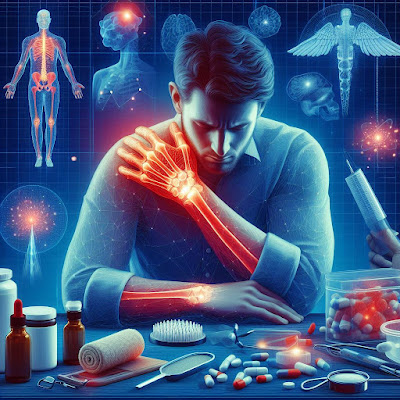Introduction:
Pain is a complex and often debilitating experience that affects millions of people worldwide. Whether acute or chronic, managing pain effectively is essential for maintaining quality of life and overall well-being. In this comprehensive guide to pain management, we'll delve into the various types of pain, explore treatment options ranging from medication to alternative therapies, and discuss lifestyle strategies for coping with and reducing pain.
 |
| Pain Management |
Understanding Types of Pain:
Pain can be classified into several categories based on its duration, location, and underlying cause. The main types of pain include:Acute Pain: Acute pain is typically short-lived and often serves as a warning sign of injury or illness. It can result from trauma, surgery, or medical conditions such as infections or inflammation.
Chronic Pain: Chronic pain persists beyond the normal healing time and may last for weeks, months, or even years. It can be caused by conditions such as arthritis, fibromyalgia, neuropathy, or back pain.
Nociceptive Pain: Nociceptive pain arises from tissue damage or inflammation and is typically localized to the affected area. Examples include cuts, burns, fractures, and muscle strains.
Neuropathic Pain: Neuropathic pain results from dysfunction or damage to the nervous system and is often described as shooting, burning, or electric shock-like sensations. Conditions such as diabetic neuropathy, postherpetic neuralgia, and sciatica can cause neuropathic pain.
Cancer Pain: Cancer-related pain can result from tumors pressing on nerves or organs, treatments such as chemotherapy or radiation therapy, or cancer-related complications. It can vary in intensity and location depending on the type and stage of cancer.
Treatment Options for Pain Management:
Effective pain management requires a multimodal approach tailored to the individual's needs and preferences. Treatment options may include:Medications:
- Over-the-counter (OTC) pain relievers: Nonsteroidal anti-inflammatory drugs (NSAIDs) such as ibuprofen and acetaminophen can help alleviate mild to moderate pain.
- Prescription medications: Opioids, muscle relaxants, antidepressants, anticonvulsants, and topical analgesics may be prescribed for more severe or chronic pain.
- Adjuvant medications: Medications such as corticosteroids, benzodiazepines, or anti-anxiety drugs may be used in combination with other pain medications to enhance their effectiveness.
Interventional Procedures:
- Injections: Epidural steroid injections, nerve blocks, trigger point injections, and joint injections can provide targeted pain relief by delivering medication directly to the source of pain.
- Radiofrequency ablation: This minimally invasive procedure uses heat to destroy nerves responsible for transmitting pain signals, offering long-lasting relief for certain types of chronic pain.
Physical Therapy and Rehabilitation:
- Exercise: Regular physical activity, stretching, and strengthening exercises can help improve flexibility, reduce stiffness, and enhance overall function.
- Manual therapy: Techniques such as massage, manipulation, and mobilization can help alleviate muscle tension, improve joint mobility, and promote relaxation.
- Modalities: Heat therapy, cold therapy, ultrasound, electrical stimulation, and traction are among the modalities used in physical therapy to relieve pain and promote healing.
Alternative and Complementary Therapies:
- Acupuncture: This ancient Chinese practice involves inserting thin needles into specific points on the body to stimulate energy flow and alleviate pain.
- Chiropractic care: Chiropractors use spinal adjustments, manipulation, and other manual techniques to address musculoskeletal issues and alleviate pain.
- Mind-body therapies: Techniques such as meditation, mindfulness, biofeedback, and relaxation training can help reduce stress, improve coping skills, and enhance pain management.
Lifestyle Strategies and Self-Care:
- Stress management: Practicing relaxation techniques, deep breathing exercises, and mindfulness meditation can help reduce stress and tension, thereby alleviating pain.
- Sleep hygiene: Establishing a regular sleep schedule, creating a comfortable sleep environment, and practicing good sleep habits can promote restful sleep and improve pain tolerance.
- Nutrition and hydration: Eating a balanced diet rich in fruits, vegetables, whole grains, and lean proteins, and staying hydrated can support overall health and reduce inflammation, which may help alleviate pain.
Conclusion: Effective pain management requires a comprehensive and individualized approach that addresses the underlying causes of pain while considering the physical, emotional, and social aspects of the individual's experience. By understanding the various types of pain, exploring diverse treatment options, and adopting healthy lifestyle strategies, individuals can take an active role in managing their pain and improving their quality of life.
[Disclaimer: This blog post is for informational purposes only and should not be considered medical advice. Always consult with a healthcare professional for personalized guidance and treatment recommendations.]







